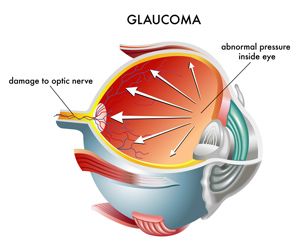Diagnosing Glaucoma
Glaucoma refers to a number of different diseases that share a common endpoint of optic nerve damage, which, at its most severe stages, can lead to visual impairment and eventual blindness. One of the most common risk factors associated with glaucoma is elevated intraocular pressure which results from fluid buildup within the anterior chamber of the eye. Several contributing factors can lead to this pressure buildup. By understanding the causes of glaucoma, we can provide treatment that helps preserve your vision.
Glaucoma is typically diagnosed through a comprehensive eye exam, testing of the peripheral vision and a sophisticated, computerized assessment of the optic nerves. Though glaucoma is not curable, it can frequently be stabilized using medication, minimally invasive laser treatment, or, in some cases, incisional glaucoma surgery. Don’t hesitate to contact SightMD today to arrange a consultation – we would be happy to help.
Glaucoma Symptoms
Primary open angle glaucoma, the most common type of glaucoma, is typically asymptomatic in its early stages. Early diagnosis and treatment of glaucoma is the best way to ensure preservation of vision. Treatment of glaucoma can prevent or delay vision degradation. Any vision loss that has already occurred is irreversible; therefore, treating the disease before it becomes symptomatic is critically important. If symptoms do occur, you may experience the following as your vision begins to deteriorate:
- Loss of peripheral vision
- Tunnel vision
- Loss of central vision, leading to blindness
If you suffer any of these symptoms, we urge you to seek treatment today. If you are an at-risk individual and have yet to experience symptoms, we still encourage you to undergo glaucoma diagnostic testing at one of our locations.

Glaucoma Causes
Though the common perception is that glaucoma refers to just one condition, the term describes a group of eye diseases that can affect the optic nerve and impair vision. Understanding these different glaucoma types allows our team to devise an effective treatment plan.
Doctors determine how to treat each patient based on the type of glaucoma that presents. From there they also determine how to monitor their patients. Because early onset glaucoma typically has no symptoms, it’s important that you have routine eye examinations as this helps to ensure that you maintain the health of your eyes. Comprehensive ophthalmic examination, and when indicated, ancillary testing, allows us to assess risk and severity of glaucoma. If you are experiencing symptoms associated with glaucoma, including loss of peripheral vision or tunnel vision, or are an at-risk patient, please don’t hesitate to contact your doctor. The earlier that treatment is sought, the better the chance of preserving your vision.
At SightMD, we educate our patients so that they understand why evaluation and treatment is necessary. Our goal is to help you make informed decisions about available treatments. During an evaluation with one of our doctors, we can discuss the results of the examination and testing in detail with you.
Risk Factors for Glaucoma
The primary factors that can lead to glaucoma include:
- Insufficient Drainage – At the angle where the iris and cornea meet, there is a soft, mesh-like tissue through which fluid drains from the anterior chamber of the eye. If this mesh-like opening does not drain eye fluid, this can lead to a buildup of fluid. From here eye pressure can elevate causing damage to the optic nerve, and eventually glaucoma.
- Damage to the Optic Nerve – Certain nutritional deficiencies, reduced blood flow, early nerve cell damage, autoimmune disease, and trauma may damage the optic nerve. In such cases, glaucoma may result. Additionally, previous eye surgery may also cause glaucoma. Uveitis, which is an inflammation of the middle layer of the eye, pigment dispersion, and pseudoexfoliation may all cause glaucoma as well.
- Genetics – Several genetic malformations can result in a greater risk of developing glaucoma. Ethnicity can also result in a predisposition to the development of glaucoma.
An understanding of these causes is essential to appropriate treatment. By treating the source of the condition, and not the symptoms, we can delay or halt the onset of glaucoma. Sight in an invaluable sense, and everyone should be able to enjoy this gift. At SightMD, we take every measure to improve our patients’ vision and ensure long-term health.
Glaucoma Diagnosis
To diagnose glaucoma, we will perform a range of tests. Designed to measure the quality of your vision and detect any potential damage to the optic nerve these tests include:
- Visual Acuity Test – A traditional eye chart test, the visual acuity evaluation allows us to examine your distance vision.
- Visual Field Test – The field evaluation allows us to examine your entire field of vision, including your periphery.
- Dilated Eye Examination – By dilating, or widening, the pupil, we can examine the retina and optic nerves, using special magnifying lenses. This allows us to look for optic nerve damage or other conditions which may affect vision.
- Tonometry – Using an instrument called a tonometer, we can measure fluid pressure inside the eye and determine whether it is abnormally high. High pressure can indicate the onset of glaucoma, or the potential for glaucoma development.
- Pachymetry – This test allows us to measure the thickness of your cornea. After numbing the eye with medicinal eye drops, we employ an instrument that emits an ultrasonic wave. This will measure corneal thickness – an independent risk factor for the development of glaucoma.
- Optical Coherence Tomography – Also known as OCT, this technique provides a non-invasive means of measuring the thickness of the retinal nerve fiber layer (RNFL). Doctors perform this by directing light at the tissue and measuring its return. The benefits of this technique are many: near-microscopic resolution of sub-surface features, non-invasive, instant results, no preparation required, and no ionizing radiation exposure. With this data, we can compare the thickness of your retinal nerve fiber layer to that of a normative database.
- Gonioscopy – This test involves the use of a specialized lens, known as a goniolens or gonioscope, with a mirror to examine the structure in the eye called the anterior chamber angle. The anterior chamber angle is an important landmark to examine clinically, as the internal drain of the eye resides in this area. Gonioscopy allows for visualization of the drain and is the most important clinical test in differentiating open angle from closed angle glaucoma. There are several different methods of gonioscopy. Each based on the different lens utilized for examination. The purpose of each test is the same however – to diagnose and monitor eye conditions.
Your doctor may want you to repeat the test during the appointment or in future appointments to see if the results are reproducible. After being diagnosed with glaucoma, visual field tests are usually done one to two times a year to track changes in your vision. If it is determined that you have glaucoma, we will discuss and implement appropriate treatment options to treat your condition most effectively.
Contact SightMD today to schedule an appointment with one of our doctors to discuss your vision health at one of our convenient locations!

Healthy Diet and Cataracts
The Role of a Healthy Diet in Preventing Cataracts As we age, various eye conditions can develop that impact…

Benefits of Cochlear Implants
Understanding the Benefits of Cochlear Implants Hearing loss can significantly impact one’s quality of life, making communication and connection…

Long-Term Considerations for Individuals with Cataracts
What to consider Long-Term for Individuals with Cataracts As we age, our eyes undergo various changes, and one common…